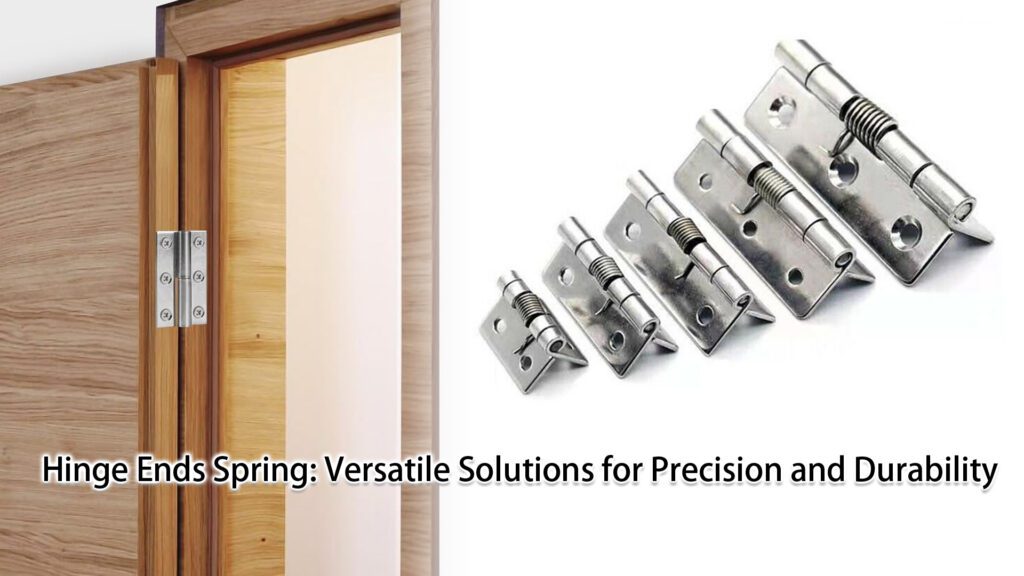Hinge ends springs are essential components in a wide range of mechanical and industrial applications. These springs, often characterized by their durable construction and unique hinge-like ends, are designed to provide reliable tension or compression, ensuring stability and functionality in various systems.
What Are Hinge Ends Springs?
Hinge ends springs are specialized mechanical springs with ends shaped like hinges or loops, enabling easy integration with other mechanical components. Made from robust materials such as stainless steel, carbon steel, or phosphor bronze, these springs can withstand high stress and offer long-lasting performance. They are typically designed for applications requiring repetitive motion, where the spring’s flexibility and durability are paramount.
Applications of Hinge Ends Springs
Hinge ends springs find applications in diverse fields due to their adaptability and precision. Key uses include:
1. Automotive Industry
- Purpose: These springs are widely used in car doors, hood hinges, and seat adjustment mechanisms.
- Benefit: Their ability to provide consistent tension ensures smooth and safe operation of automotive parts.
2. Furniture and Home Appliances
- Purpose: In recliners, kitchen cabinets, and appliance doors, hinge ends springs facilitate controlled movement and secure positioning.
- Benefit: They enhance the usability and durability of furniture and appliances by reducing wear and tear.
3. Machinery and Industrial Equipment
- Purpose: Hinge ends springs are integral to conveyor belts, latches, and other mechanical systems requiring repetitive motion.
- Benefit: Their resilience and ability to handle high loads make them ideal for heavy-duty applications.
4. Medical Devices
- Purpose: In medical equipment such as surgical instruments and rehabilitation devices, these springs enable precise motion control.
- Benefit: The springs ensure reliable performance, critical for patient safety and equipment effectiveness.
Key Features and Advantages
Hinge ends springs are prized for their unique properties:
1. Versatility
- Their hinge-like ends allow for easy attachment to various components, making them suitable for multiple applications.
2. Durability
- Constructed from high-quality materials, these springs resist corrosion and fatigue, ensuring long-term reliability even in demanding environments.
3. Compact Design
- Despite their strength, hinge ends springs are compact and lightweight, making them ideal for applications with space constraints.
4. Customization
- Manufacturers can tailor these springs to meet specific requirements, such as load capacity, size, and material, ensuring optimal performance.
Advantages Over Other Spring Types
Hinge ends springs offer distinct advantages over other spring designs:
- Ease of Integration: Their specialized ends simplify attachment, reducing installation time and effort.
- Enhanced Stability: The hinge ends provide additional support, minimizing the risk of misalignment or malfunction.
- Wide Compatibility: These springs are compatible with a variety of mechanical systems, making them a versatile choice.
Conclusion: Why Hinge Ends Springs Matter
Hinge ends springs are more than just mechanical components; they are critical to the smooth and efficient operation of countless systems. From automobiles to medical devices, their adaptability, strength, and precision make them indispensable.
Could the ever-expanding applications of hinge ends springs redefine mechanical design in the future? What innovative uses might emerge as industries continue to push the boundaries of technology?
References
- Mechanical Design Today, Issue 45, July 2022, “The Role of Springs in Modern Engineering”
- Industrial Equipment Review, Vol. 18, March 2023, “Custom Springs: Tailored Solutions for Complex Systems”
- Automotive Mechanics Monthly, November 2021, “Springs in Motion: Enhancing Durability and Efficiency”

